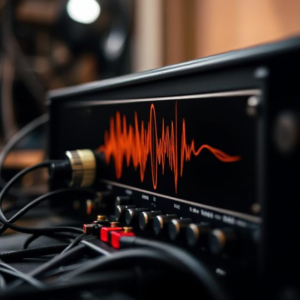1. Amplifier Distortion:
An amplifier’s main job is to take a weak electrical signal (like from an instrument, microphone, etc.) and make it stronger. But sometimes, the amplifier doesn’t just make the signal louder – it can also change or distort the sound. This is what we call distortion.
Distortion can happen when:
- The signal is too strong for the amplifier to handle (it “overdrives”).
- The amplifier is intentionally designed to add a certain kind of “gritty” or “fuzzy” sound (like in electric guitar amps for that classic rock tone).

There are two types of distortion:
- Clean distortion (also known as “clipping”) happens when the amplifier starts to push the signal too hard, causing the waveform to flatten out. This results in harsh, gritty sound.
- Overdrive/distortion effects are actually designed to create that sound, which is why guitarists use them to get that edgy, crunchy tone.
2. Feedback:
Now, let’s talk about feedback in the context of amplifiers. Feedback is when the sound from the speaker (or output) gets picked up by a microphone (or input), goes through the amplifier again, and starts creating a loop. This can cause the amplifier to keep amplifying the sound, which leads to a loud, often high-pitched “squeal” or “howl.”
Positive Feedback:
- In a negative feedback system, the amplifier tries to reduce distortion and keep the sound clean. But positive feedback happens when the output (the sound) keeps getting amplified in a loop. This is what happens in cases of loud ringing or howling sounds from a microphone near a speaker.
- You may hear this as the classic “feedback” sound, especially in concerts when a mic is too close to a speaker.
Some amplifiers are designed to use controlled feedback to intentionally modify sound. For example, guitarists may use feedback to get that sustained, screaming note.
Summary:
- Distortion happens when an amplifier overdrives a signal, either by accident (overloading) or on purpose (like in guitars for a specific sound).
- Feedback is when the sound from the speaker gets picked up by the mic and creates a looping effect that can lead to loud squeals.
Tags: amplification loop, Amplifier, clean distortion, clipping, controlled feedback., crunchy tone, distortion, distortion effects, edgy tone, electric guitar amps, electrical signal, feedback, Feedback Loop, fuzzy sound, gritty sound, guitar feedback, harsh sound, howl, howling sound, instrument, loud ringing, microphone, microphone proximity, Negative Feedback, overdrive, overdrive effects, Positive Feedback, ringing sound, rock tone, sound amplification, sound modification, speaker, squeal, sustained note, waveform


